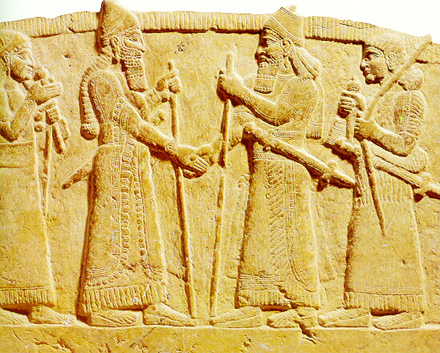
(This is an excerpt from ‘Seething Cauldron: Essays on Zoroastrianism, Sufism, Freemasonry, Wicca, Druidry, and Thelema’. By Nabarz. ISBN: 978-0-9556858-4-2. Available on Amazon and http://www.lulu.com/spotlight/webofwyrd):
The debate about the origins of the Roman Mithras continues, and, while it is clear that the Roman Cult of Mithras was a syncretic religion using elements of Greek, Roman, and Persian cultures; it is less clear how influential different elements were in the production of the final Roman Cult. One aspect worth considering in the debate is the parallel between the act of the handshake, as seen in both the Persian Mithra and the Roman Mithras traditions. In modern times, shaking hands with the right hand is generally viewed as a sign of trust, as it shows no weapon is being held in the weapon bearing hand.
The oldest forms of handshakes were practiced by Babylonian Kings c. 1800 BCE, who had to ‘take the hands of Marduk’ before assuming the throne. According to Sir J. Frazer in The Golden Bough: ‘At Babylon, within historical times, the tenure of the Kingly office was in practice lifelong, yet in theory it would seem to have been merely annual. For every year at the festival of Zagmuk the king had to renew his power by seizing the hands of the image of Marduk in his great temple of Esagil at Babylon. Even when Babylon passed under the power of Assyria, the monarchs of that country were expected to legalise their claim to the throne every year by coming to Babylon and performing the ancient ceremony at the New Year festival.’[1]
The earliest mention of Mithra is on a 14th century BCE clay tablet, where he is the guarantor of an agreement between the Hittites and Mitanni. Mithra is the god of contracts and agreement, his name in Avestan means Treaty or Contract.
Antiochus I of Commagene, c.69 to c.31 BCE, on the Nemrud Dagh is shown shaking his right hand with Mithra’s right hand. Mithra has his radiant crown and his Phrygian looking cap and cloak on his shoulders. Mithra in his left hand holds the Barsom the sacred twigs, as he is described as doing in the Zoroastrian Avesta. This right handed hand-shake between the King and Mithra back in ca50 BCE might seem trivial at first, after all Antiochus I also shakes hands with other deities at Nemrud Dagh including Ahura Mazda as well as Mithra. However, Mithra means ‘contract’; he is the god of agreements and oaths, a point also mentioned by Professor Clauss: ‘Mithra was god of the oath, protector of oaths. He was god of good faith, of agreements, of loyalty. Plutarch has an anecdote of how the Great King reminded one of his servants that he had bound himself to loyalty by shaking hands and by swearing by Mithra: Tell me (the truth), keeping faith with the light of Mithra and the King’s right hand’ (Vit Alex 30.8). [3]
This relief from Taq-e Bostan near Kermanshah, Iran, showing the investiture scene of Ardashir II (379–383 CE) of the Sasanian Empire. In middle the king is being given the right to rule, the divine kingship by Ahura Mazda, who hands the diadem with his right hand to the king’s right hand. The two stand on a prostrate enemy. On the left is Mithra, wearing a crown of sun-rays, holding holy barsom twigs, and standing on a sacred lotus flower, he is also giving his blessings to his rule. One of duties of Mithra was to protect the Kingly Fortune or Divine Glory (khvarnah or Farr). The hymn to Mithra (Yasht 10) speaks of the divinity as the bestower of khvarnah.
The above examples show how in the ancient Middle Eastern Empires, the shaking of hands with the gods allowed the divine right of Kingship to be bestowed on the Kings by physical contact with a representation of the deity. This is a divine contract being formed when the handshake takes place, be it a peace treaty or the giving of the right to rule. The act transforms the person to stand in line with the Gods.
The divine handshake is taken from the Persian Mithra to the Roman Mithras; however, before examining this there are several other examples of right handed handshakes that need to be examined in part 2.
[1] http://www.sacred-texts.com/pag/frazer/gb02403.htm
[2] http://prophetess.lstc.edu/~rklein/images/shalthe3… reproduced here with kind permission of Prof Ralph W.Klein.
[3] Manfred Clauss, The Roman Cult of Mithras: The God and His Mysteries (Edinburgh, Scotland: Edinburgh University Press, 2000), p4.
[4] The Mysteries of Mithra, by Franz Cumont. New York: Dover, 1956. [Originally published in 1903 by Open Court Publishing, London.] Also available online: http://www.sacred-texts.com/cla/mom/
[5] The Mysteries of Mithra, by Franz Cumont. New York: Dover, 1956. [Originally published in 1903 by Open Court Publishing, London.]
[6] http://commons.wikimedia.org/wiki/Image:Taq-e_Bost… Photo by ‘Philippe Chavin’ reproduced here with his kind permission.






